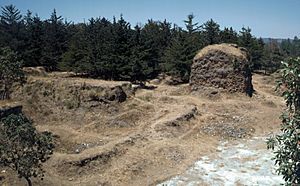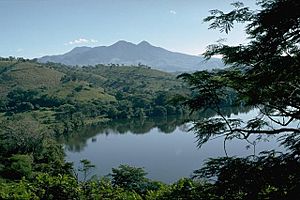Pedro de Alvarado facts for kids
```wikitext
Quick facts for kids
Pedro de Alvarado
|
|
|---|---|

1906 portrait of Alvarado by Tomás Povedano
|
|
| Born | c. 1485 |
| Died | 4 July 1541 |
| Spouse(s) |
Dona Luisa
(m. 1519; Francisca de la Cueva (m. 1527; died c. 1532) |
| Children | 5 (3 with Luisa) |
| Signature | |
 |
|
Pedro de Alvarado (born around 1485 – died July 4, 1541) was a Spanish conquistador and governor of Guatemala. He played a big part in the Spanish conquest of the Americas. He helped conquer Cuba and explored the coasts of the Yucatán Peninsula. Alvarado was also a key leader in the conquest of the Aztec Empire alongside Hernán Cortés. He is known for conquering large parts of Central America, including Guatemala, Honduras, and El Salvador.
Contents
- Pedro de Alvarado: A Spanish Conquistador
- What Was Pedro de Alvarado Like?
- Early Life and Family Background
- First Journeys to the Americas
- Exploring Mexico with Cortés (1519)
- Conquering Soconusco and Guatemala
- Conquest of Cuzcatlan (El Salvador)
- Titles and Marriages
- Expedition to Peru
- Governor of Honduras
- Death in the Mixtón War (1541)
- Family Life
- See also
Pedro de Alvarado: A Spanish Conquistador
What Was Pedro de Alvarado Like?
Pedro de Alvarado was a very colorful and strong leader. He was a brilliant military commander, but also known for being very cruel. People described him as handsome and friendly looking, but he could get angry very quickly. The Aztecs even called him Tōnatiuh, meaning "Sun," because of his blond hair and fiery temper.
Alvarado was often very harsh with the native people he conquered. Many historians believe his desire for wealth made him act with extreme cruelty. Even other Spanish people at the time criticized how brutal he was. He wasn't very good at governing the lands he conquered. Instead, he always looked for new adventures and more lands to explore.
His harsh actions, like the massacre in the Great Temple of Tenochtitlan, sometimes made his overall plans harder. He was also accused of being cruel to other Spaniards. Alvarado didn't seem interested in peaceful matters or setting up stable governments. His letters mostly talked about exploring and war. He also resisted the Spanish Crown's attempts to collect taxes in Guatemala. One historian described him as "an insatiable despot" who saw Guatemala as his own personal property.
A Spanish writer, Antonio de Remesal, said that Alvarado "desired more to be feared than loved." While other conquistadors like Hernán Cortés and Francisco Pizarro also did cruel things, Alvarado often faced more criticism for his actions.
Early Life and Family Background
Pedro de Alvarado was born in 1485 in Badajoz, a town in Extremadura, Spain. His father was Gómez de Alvarado, and his mother was Leonor de Contreras. Pedro had a twin sister named Sarra and four full brothers: Jorge, Gonzalo, Gómez, and Juan. He also had a half-brother, also named Juan.
Not much is known about Alvarado's early life before he came to the Americas. Some popular stories about his youth in Spain might not be entirely true. For example, one tale says that he once climbed a church tower in Seville and walked out onto a long banner pole, showing how brave and daring he was.
Alvarado came from a family with some influence. His grandfather was Juan Alvarado "the elder," and his uncle, Diego de Alvarado y Messía, was a veteran of the wars against the Moors in Spain.
First Journeys to the Americas
Pedro de Alvarado and his brothers traveled across the Atlantic Ocean before 1511. They first stopped in Hispaniola, which is now Haiti and the Dominican Republic. There aren't many records of their time there.
Soon after arriving in Santo Domingo, Hispaniola, Pedro de Alvarado became friends with Hernán Cortés. Cortés was working as a public scribe at the time. Alvarado then joined Cortés in the conquest of Cuba, which began in 1511. His brothers also came along. After the conquest, Alvarado became a successful farm owner in the new colony. This is when he started to become known as a wealthy and important person, with good connections to Diego de Velázquez, who was the governor of Cuba.
The Grijalva Expedition (1518)
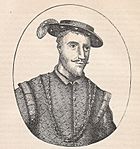
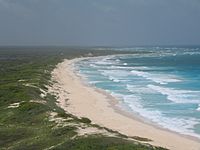
Diego Velázquez, the governor of Cuba, was excited by reports of gold in the newly found Yucatán Peninsula. He organized an expedition with four ships and 260 men. He put his nephew, Juan de Grijalva, in charge. Pedro de Alvarado was the captain of one of the ships. The ships were filled with weapons, trade goods, and food.
The fleet left Cuba in April 1518 and first landed on the island of Cozumel, off the east coast of Yucatán. The Maya people of Cozumel ran away from the Spanish. The fleet then sailed south, seeing three large Maya cities along the coast.
Grijalva did not land at these cities. Instead, he sailed north around the Yucatán Peninsula and then down the west coast. At Campeche, the Spanish fired their small cannons at the city. The people fled, and the Spanish took the empty city. The Maya stayed hidden in the forest, so the Spanish got back on their ships and continued sailing.
At Champotón, war canoes approached the fleet, but the ships' cannons scared them away. At the mouth of the Tabasco River, the Spanish saw many warriors and canoes. Grijalva used interpreters to trade wine and beads for food and other supplies. From the natives, they received some gold jewelry and heard about the rich Aztec Empire to the west. The expedition continued far enough north to confirm that this gold-rich empire was real.
At the Papaloapan River, Alvarado sailed his ship upriver without orders, leaving the rest of the fleet behind. This made Grijalva very angry because a single ship could easily be lost. After this, the Spanish called the river "Alvarado's River." Further along the coast, the fleet found settlements controlled by the Aztecs. Aztec messengers came with gifts of gold and jewels from Emperor Moctezuma II.
As punishment for going up the Papaloapan River without orders, Grijalva sent Alvarado back to Cuba with his ship, the San Sebastián. Alvarado arrived in Santiago de Cuba triumphantly, showing off the wealth they had found. His early return allowed him to gain favor with Governor Velázquez before Grijalva came back. Alvarado turned the governor against Grijalva, claiming much of the expedition's success for himself.
Exploring Mexico with Cortés (1519)
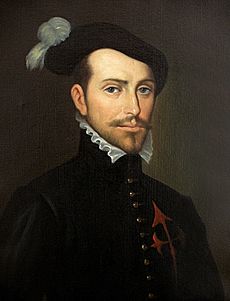
Grijalva's return sparked great interest in Cuba. A new expedition was quickly put together with eleven ships, 500 men, and some horses. Hernán Cortés was put in charge. Pedro de Alvarado and his brothers Jorge, Gómez, and Juan "El Bastardo" joined this important journey. Cortés asked Pedro de Alvarado to find new recruits from the farms in Cuba. The crew included future famous conquistadors like Cristóbal de Olid and Gonzalo de Sandoval. Veterans from the Grijalva expedition, such as Bernal Díaz del Castillo, were also on board.
Alvarado again commanded the ship San Sebastián, leading 60 men. The fleet first landed at Cozumel and stayed there for several days. They pulled down Maya temples and put up a Christian cross. From Cozumel, the fleet sailed around the north of the Yucatán Peninsula and followed the coast to the Tabasco River. In Tabasco, the fleet anchored at Potonchán, a Chontal Maya town. The Maya got ready for battle, but the Spanish horses and firearms quickly won the fight.
From Potonchán, the fleet continued to San Juan de Ulua. The crew stayed there only a short time before moving to a spot near Quiahuiztlan and Cempoala, a city that was part of the Aztec Empire. Some Spaniards stayed near the coast, but Alvarado went with Cortés on the march inland. On their way to Tenochtitlan, the expedition went through Tlaxcalteca lands. The Tlaxcalteca attacked the Spanish many times, but they could not defeat them. After making an alliance with the Tlaxcalteca, the Spanish went on to conquer the Aztecs.
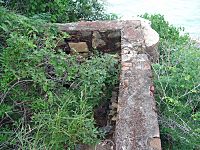
Alvarado was in charge of one of the ships and was Cortés's second-in-command during their first stay in the Aztec capital city of Tenochtitlan. The Spanish and their hosts did not get along well, especially because Cortés kept telling the Aztecs to stop idol worship and human sacrifice. To keep themselves safe, the Spanish took the Aztec king Moctezuma II as a hostage. When Cortés had to go back to the coast to deal with a new Spanish expedition led by Pánfilo de Narváez, Alvarado stayed in Tenochtitlan. He was given strict orders to make sure Moctezuma did not escape.
While Cortés was away, relations between the Spanish and the Aztecs got much worse. Alvarado led a massacre of Aztec nobles and priests during a religious festival. Alvarado claimed he did this because he feared the Aztecs were planning against him. However, there is no real proof for this claim, and the warnings he supposedly received came from tortured captives who might have said anything to stop the pain. When Cortés returned to Tenochtitlan, he found the Spanish under attack. After Moctezuma was killed while trying to talk to his own people, the Spanish decided to escape by fighting their way across one of the causeways (raised roads) that led from the city over the lake to the mainland.
In a very bloody night battle on July 10, 1520, known as La Noche Triste (The Sad Night), Alvarado led the group at the back and was badly hurt. A famous story says Alvarado made a great leap across a gap in the causeway during the escape. This event became known as Salto de Alvarado ("Alvarado's Leap").
Pedro then took part in the Siege of Tenochtitlan. He commanded one of the four forces under Cortés. Alvarado was wounded when Cuauhtemoc attacked all three Spanish camps. Alvarado's group was the first to reach the Tlateloco marketplace, where they set fire to the Aztec shrines. Cortés's and Sandoval's groups joined him there after four more days of fighting.
Conquering Soconusco and Guatemala
Cortés sent Pedro de Alvarado to invade Guatemala. Alvarado had 180 cavalry (soldiers on horseback), 300 infantry (soldiers on foot), crossbows, muskets, 4 cannons, lots of ammunition, and thousands of allied Mexican warriors. In 1523, Pedro de Alvarado passed through Soconusco with a large army on his way to conquer Guatemala. Alvarado's army included experienced soldiers from the conquest of the Aztecs. They also had many native allies from Cholula, Tenochtitlan, Texcoco, Tlaxcala, and Xochimilco.
The people of Soconusco welcomed Alvarado peacefully and promised to be loyal to the Spanish Crown. They told him that nearby groups in Guatemala were attacking them because they were friendly to the Spanish. By 1524, Alvarado and his forces had completely brought Soconusco under Spanish control.
Pedro de Alvarado and his army marched along the Pacific coast without problems until they reached the Samalá River in western Guatemala. This area was part of the K'iche' kingdom. A K'iche' army tried to stop the Spanish from crossing the river but failed. Once across, the Spanish soldiers looted nearby settlements to scare the K'iche' people. On February 8, 1524, Alvarado's army fought a battle at Xetulul, which his Mexican allies called Zapotitlán (now San Francisco Zapotitlán). Even though K'iche' archers injured many, the Spanish and their allies stormed the town and set up camp.
Alvarado then headed upriver into the Sierra Madre mountains towards the K'iche' heartland. He crossed a pass into the fertile valley of Quetzaltenango. On February 12, 1524, K'iche' warriors ambushed Alvarado's Mexican allies in the pass and pushed them back. However, the Spanish cavalry charge that followed was a big shock for the K'iche', who had never seen horses before. The cavalry scattered the K'iche' army, and the Spanish army reached the city of Xelaju (modern Quetzaltenango), only to find it empty.
About a week later, on February 18, 1524, a K'iche' army faced the Spanish army in the Quetzaltenango valley. The K'iche' were completely defeated, and many K'iche' nobles died. This battle weakened the K'iche' army greatly. They asked for peace and offered gifts, inviting Pedro de Alvarado into their capital, Q'umarkaj, which was known as Tecpan Utatlan to the Spanish allies. Alvarado was very suspicious of the K'iche's intentions, but he accepted the offer and marched to Q'umarkaj with his army.
In March 1524, Pedro de Alvarado entered Q'umarkaj after being invited by the K'iche' lords. He was afraid it was a trap, so he camped on the plain outside the city instead of staying inside. He worried that his cavalry would not be able to move well in the narrow streets of Q'umarkaj. He invited the main lords of the city, Oxib-Keh (the king) and Beleheb-Tzy (the king elect), to visit him in his camp.
As soon as they arrived, he captured them and held them prisoner. The K'iche' warriors, seeing their lords captured, attacked the Spanish native allies and managed to kill one Spanish soldier. At this point, Alvarado decided to burn the captured K'iche' lords to death. He then burned the entire city. After destroying Q'umarkaj and executing its rulers, Pedro de Alvarado sent messages to Iximche, the capital of the Kaqchikel people. He suggested an alliance against the remaining K'iche' resistance.
Alliance with the Kaqchikel and Tz'utujil Conquest
On April 14, 1524, shortly after defeating the K'iche', the Spanish were invited into Iximche. The Kaqchikel lords, Belehe Qat and Cahi Imox, welcomed them. The Kaqchikel kings provided native soldiers to help the Spanish fight the remaining K'iche' and defeat the nearby Tz'utujil kingdom. The Spanish only stayed briefly in Iximche before continuing through Atitlán, Escuintla, and Cuscatlán. The Spanish returned to the Kaqchikel capital on July 23, 1524. On July 27, Pedro de Alvarado declared Iximche the first capital of Guatemala, naming it Santiago de los Caballeros de Guatemala.
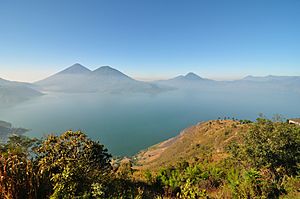
The Kaqchikel seemed to have allied with the Spanish to defeat their enemies, the Tz'utujil. The Tz'utujil capital was Tecpan Atitlan. Pedro de Alvarado sent two Kaqchikel messengers to Tecpan Atitlan at the request of the Kaqchikel lords, but the Tz'utujil killed both of them. When news of the messengers' deaths reached the Spanish at Iximche, the conquistadors marched against the Tz'utujil with their Kaqchikel allies.
Pedro de Alvarado left Iximche just five days after arriving there. He had 60 cavalry, 150 Spanish foot soldiers, and many Kaqchikel warriors. The Spanish and their allies reached the lakeshore after a day's hard march without meeting any resistance. Seeing no opposition, Alvarado rode ahead with 30 cavalry along the lake shore. Opposite a populated island, the Spanish finally met hostile Tz'utujil warriors. They charged among them, scattering them and chasing them to a narrow causeway where the surviving Tz'utujil fled. The rest of Alvarado's army soon joined his group, and they successfully stormed the island. This battle happened on April 18.
The next day, the Spanish entered Tecpan Atitlan but found it empty. Pedro de Alvarado camped in the city center and sent out scouts to find the enemy. They managed to capture some local people and used them to send messages to the Tz'utujil lords, ordering them to surrender to the king of Spain. The Tz'utujil leaders responded by surrendering to Pedro de Alvarado and promising loyalty to Spain. At this point, Alvarado considered them peaceful and returned to Iximche. Three days after Pedro de Alvarado returned to Iximche, the lords of the Tz'utujil arrived there to pledge their loyalty and offer gifts to the conquistadors. Soon after, several lords from the Pacific lowlands also came to swear loyalty to the king of Spain.
Kaqchikel Rebellion and Pacific Lowlands
Pedro de Alvarado quickly started demanding gold from the Kaqchikels as tribute. This ruined the friendship between the two groups. He demanded that their kings give him 1000 gold leaves, each worth 15 pesos. Because of these demands, the Kaqchikel people left their city and fled to the forests and hills on August 28, 1524. Ten days later, the Spanish declared war on the Kaqchikel.
Two years later, on February 9, 1526, a group of sixteen Spanish soldiers who had left the army burned the palace of the Ahpo Xahil, looted the temples, and kidnapped a priest. The Kaqchikel blamed these actions on Pedro de Alvarado. The Kaqchikel continued to fight against the Spanish for several years. On May 9, 1530, tired from the war that had killed their best warriors and forced them to abandon their crops, the two kings of the most important clans returned from the wilderness. A day later, many nobles and their families, and many more people, joined them. They then surrendered at the new Spanish capital at Ciudad Vieja.
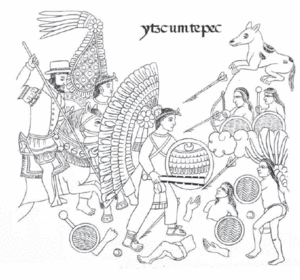
On May 8, 1524, Pedro de Alvarado continued south to the Pacific coastal plain with an army of about 6000 men. He defeated the Pipil people of Panacal or Panacaltepeque near Izcuintepeque on May 9. Alvarado described the land leading to the town as very difficult, with thick plants and swamps that made it impossible to use cavalry. Instead, he sent men with crossbows ahead. The Pipil pulled back their scouts because of the heavy rain, believing the Spanish and their allies would not reach the town that day.
Pedro de Alvarado pushed forward, and when the Spanish entered the town, the defenders were completely unprepared. The Pipil warriors were inside, sheltering from the heavy rain. In the battle that followed, the Spanish and their native allies had only minor losses. However, the Pipil were able to escape into the forest, protected from Spanish pursuit by the weather and thick plants. Pedro de Alvarado ordered the town to be burned and sent messengers to the Pipil lords demanding their surrender. He threatened to destroy their lands if they did not.
According to Alvarado's letter to Cortés, the Pipil came back to the town and surrendered to him, accepting the king of Spain as their ruler. The Spanish force camped in the captured town for eight days. A few years later, in 1529, Pedro de Alvarado was accused of being too brutal in his conquest of Izcuintepeque, among other terrible acts.
In Guazacapán, Pedro de Alvarado met people who were neither Maya nor Pipil. They spoke a completely different language; these were likely the Xinca people. At this point, Alvarado's force had 250 Spanish foot soldiers and 6,000 native allies, mostly Kaqchikel and Cholutec. Alvarado and his army defeated and took control of the most important Xinca city, called Atiquipaque. Alvarado described the defending warriors as fighting fiercely with spears, stakes, and poisoned arrows. The battle happened on May 26, 1524, and greatly reduced the Xinca population.
Alvarado's army continued east from Atiquipaque, capturing several more Xinca cities. Because Alvarado and his allies could not understand the Xinca language, Alvarado took extra care on the march east. He strengthened his front and back groups with ten cavalry each. Despite these precautions, a Xinca army ambushed the baggage train soon after they left Taxisco. Many native allies were killed, and most of the baggage was lost, including all the crossbows and iron parts for the horses.
This was a serious setback. Alvarado camped his army in Nancintla for eight days. During this time, he sent two expeditions against the attacking army. Alvarado sent Xinca messengers to contact the enemy, but they did not return. Messengers from the city of Pazaco, in the modern department of Jutiapa, offered peace to the Spanish. But when Alvarado arrived there the next day, the people were preparing for war. Alvarado's troops met a large number of gathered warriors and quickly defeated them through the city's streets. From Pazaco, Alvarado crossed the Río Paz and entered what is now El Salvador.
Conquest of Cuzcatlan (El Salvador)
Alvarado led the first Spanish attempt to extend their rule to the nation of Cuzcatlan (in modern El Salvador) in June 1524. These efforts led to the founding of many towns, like San José Acatempa in 1525. However, the native people, known as the Pipil, and their Mayan-speaking neighbors strongly resisted the Spanish. Even though Alvarado had early success in the Battle of Acajutla, the native people of Cuzcatlán, who were supposedly led by a warlord named Atlácatl, defeated the Spanish and their helpers. They forced them to go back to Guatemala.
Alvarado was wounded in his left thigh, which left him with a limp for the rest of his life. He stopped leading the war and appointed his brother, Gonzalo de Alvarado, to continue the task. Two more expeditions were needed (the first in 1525, followed by a smaller group in 1528) to bring the Pipil under Spanish control. In 1528, the conquest of Cuzcatlán was finished, and the city of San Salvador was founded.
Titles and Marriages
On December 18, 1527, the king of Spain named Alvarado as governor of Guatemala. Two days later, he gave him the important military title of Adelantado. Alvarado's close friendship with Cortés ended in the same year. Alvarado had promised Cortés that he would marry Cecilia Vázquez, Cortés's cousin. However, Alvarado broke his promise and instead married Francisca de la Cueva.
Technically, this was not his first marriage. He had married an indigenous woman, the daughter of Xicotencatl the Elder, who was known as Dona Luisa by Spanish speakers. Francisca de la Cueva had good connections at the royal court. She was the niece of Francisco de los Cobos, the king's secretary, and came from a powerful noble family. This marriage gave Alvarado more influence at court and was much more helpful for his long-term goals. Alvarado remained friends with Francisco de los Cobos, which helped him stay in the king's favor. In 1528, Alvarado and Cortés happened to be in Seville at the same time, but Cortés ignored him.
Francisca de la Cueva died shortly after they arrived in America. Alvarado remained governor of Guatemala until his death. He was made a Knight of Santiago in 1527.
Expedition to Peru
By 1532, Alvarado's friendship with Hernán Cortés had turned sour, and he no longer trusted him. At this time, Alvarado asked the king for permission to lead an expedition south along the Pacific coast. He wanted to conquer any lands there that had not yet been claimed by Spain, and he specifically asked that Cortés not join him. In 1534, Alvarado heard stories about the riches of Peru. He headed south to the Andes mountains and tried to take control of the province of Quito. When he arrived, he found that the land was already held by Francisco Pizarro's officer, Sebastián de Belalcázar. The two groups of Conquistadors almost fought. However, Alvarado traded most of his ships, horses, and weapons, plus most of his men, to Pizarro's group for a fair amount of money. He then returned to Guatemala.
Governor of Honduras
In 1532, Alvarado received a royal order naming him Governor of the Province of Honduras. At that time, Honduras only had one Spanish settlement in Trujillo, but he chose not to act on this appointment. In 1533 or 1534, he began sending his own groups of enslaved Africans and Native Americans into parts of Honduras next to Guatemala to work in the gold mines.
In 1536, Alvarado and his army of native allies arrived in Honduras. He came after receiving a letter asking for help from Andrés de Cereceda, who was acting Governor of Honduras. The Spanish colonists were about to leave the country to look for gold in Peru. In June 1536, Alvarado fought and defeated the native resistance led by Cicumba in the lower Ulua river valley. He then divided the native labor among his soldiers and some colonists and returned to Guatemala.
During a visit to Spain in 1537, Alvarado had his governorship of Honduras confirmed again, in addition to Guatemala, for the next seven years. His control over Honduras was not without challenges. Francisco de Montejo had a competing claim and was made Governor of Honduras by the Spanish king in 1540. Ten years after his first wife died, Alvarado married one of her sisters, Beatriz de la Cueva, who outlived him.
After Alvarado's death, Beatriz de la Cueva managed to get herself elected and became governor of Guatemala. She was the only woman to govern a major political area in the Americas during Spanish colonial times. She drowned a few days after taking office when the capital city Ciudad Vieja was destroyed by a sudden mudflow from the Volcán de Agua in 1541.
Death in the Mixtón War (1541)
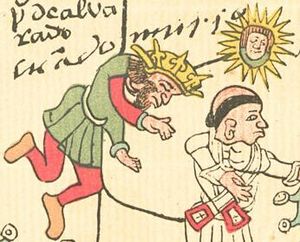

Alvarado planned to prepare a large fleet of ships that would sail from the western coast of Mexico to China and the Spice Islands. At great expense, he gathered and equipped 13 ships and about 550 soldiers for this expedition. The fleet was about to set sail in 1541 when Alvarado received a letter from Cristóbal de Oñate. Oñate was asking for help against hostile native groups who were attacking him at Nochistlán.
This attack was part of a major uprising by the Mixtón natives in the Nueva Galicia region of Mexico. Alvarado gathered his troops and went to help Oñate. In a strange accident, he was crushed by a horse that got scared and ran wild. He died a few days later, on July 4, 1541. He was buried in the church at Tiripetío, a village between Pátzcuaro and Morelia (in present-day Michoacán).
Forty years after Alvarado's death, his mestiza daughter, Leonor de Alvarado Xicoténcatl, paid to have his remains moved to Guatemala. He was reburied in the cathedral of the city of Santiago de los Caballeros de Guatemala, which is now Antigua Guatemala.
Family Life
After her husband's death, Beatriz de la Cueva managed to get herself elected and became governor of Guatemala. She was the only woman to govern a major political area in the Americas during Spanish colonial times.
Alvarado did not have any children from his legal marriages. His long-term partner was his concubine, Luisa de Tlaxcala (also called Xicoténcatl or Tecubalsi, her original names after Catholic baptism). She was a Nahua noblewoman, the daughter of the Tlaxcallan King Xicotencatl the Elder. Luisa was given by her father in 1519 to Hernán Cortés as a sign of respect and friendship. Cortés then gave her "in guard" to Pedro de Alvarado, who quickly became her partner. Luisa followed Alvarado in his conquests beyond central Mexico. Even though she was never his legal wife, Luisa de Tlaxcala owned many things and was respected as a Doña, both because of her relationship with Alvarado and her noble background. She died in 1535 and was buried at the Guatemala Cathedral.
Pedro de Alvarado had three children with Luisa de Tlaxcala:
- Leonor de Alvarado y Xicotenga Tecubalsi, born in the newly founded Spanish city of Santiago de los Caballeros. She married Pedro de Portocarrero, a conqueror trusted by her father. He joined Alvarado during the conquests of Mexico and Guatemala and fought in many battles against the native peoples.
- Leonor married a second time to Francisco de la Cueva y Guzman. The Alvarado family's wealth stayed with their descendants for many generations through the Villacreces de la Cueva y Guzmán family, who were governors of this part of Guatemala.
- Pedro de Alvarado, named after his father, who disappeared at sea while traveling to Spain.
- Diego de Alvarardo, El Mestizo, who died in 1554 during the civil wars in Peru.
He had two other children from other relationships:
- Gómez de Alvarado, about whom little else is known.
- Ana (Anita) de Alvarado.
See also
 In Spanish: Pedro de Alvarado para niños ```
In Spanish: Pedro de Alvarado para niños ```


